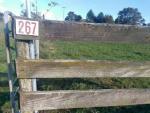In order to ensure that emergency services can find an address in an emergency, Ōpōtiki District Council has decided to undertake a significant project ensuring that all addresses meet the New Zealand Standard Rural and Urban Addressing.
The project covers two key areas – applying a consistent approach to Rapid Numbers and ensuring that all roads in the district are named, and named according to the rules.
RAPID stands for Rural Address Property Identification. It gives every rural property with a dwelling an address. This means that people can identify exactly where you are in rural areas. It is crucial for emergency services such as Police, ambulance, fire service and Civil Defence and it may be required by a telecommunications or power company before they make a new connection.
“For a number of years, we have heard anecdotally that people are just choosing the next number in the sequence after their neighbour and attaching that to their letterbox. While I haven’t seen this myself, if it was the case, it could be very dangerous.
“Rapid numbers are in fact a specific distance from a known point – usually the road you are on. But in order for them to work, they need to be consistent and understood. Only the Council can issue a Rapid Number and there are a number of rules we need to follow to do that. We also make sure that the information is on the LINZ national property database so that emergency services can then accurately locate properties when they need to,” said Gerard McCormack, Planning and Regulatory Group Manager Ōpōtiki District Council.
St John Opotiki Station Manager, Mike Norman agreed.
“In our line of work, a consistent and understood address is vital and could save lives. The first and most important thing we need to know when someone calls 111 is the exact address of the emergency. Rural areas in the Ōpōtiki District can be isolated and difficult to locate for emergency services and the rapid numbers are our best guide. We rely on them very heavily, and have had problems in the past locating properties when responding to emergencies” Mr Norman said.
Generally, rapid numbers are the responsibility of the property owner, but as part of this project, Council is reviewing all property addresses and sending out replacement numbers where they are required.
“We’ll be sending letters to owners if they need a number change and providing them with the new number to put up. We will let emergency services, electricity and phone companies know but people will need to let anyone else that uses the number know.
“Once we know that the numbers are consistent across the district, any future replacements or new numbers will need to go through the usual process of application and allocation. Although it isn’t difficult and you can do it on the website,” Mr McCormack said.
The other part of the project is ensuring that all the roads in the district are named, and that the names don’t break the rules set out by LINZ.
“We are doing this for the same reasons as the Rapid Numbering and at the same time – it is about consistency so that an address is easy to find.
“This process will require a lot of consultation with the public as we need to name all unnamed roads, Māori roads and identify and name any private roads. It is a big project and we expect that people will have strong feelings on new names or old names. People can expect to hear more about this over the coming months,” Mr McCormack said.
More information about the project and about Rapid Numbers generally on the Council website www.odc.govt.nz/rapidnumbers
Source: Opotiki District Council

